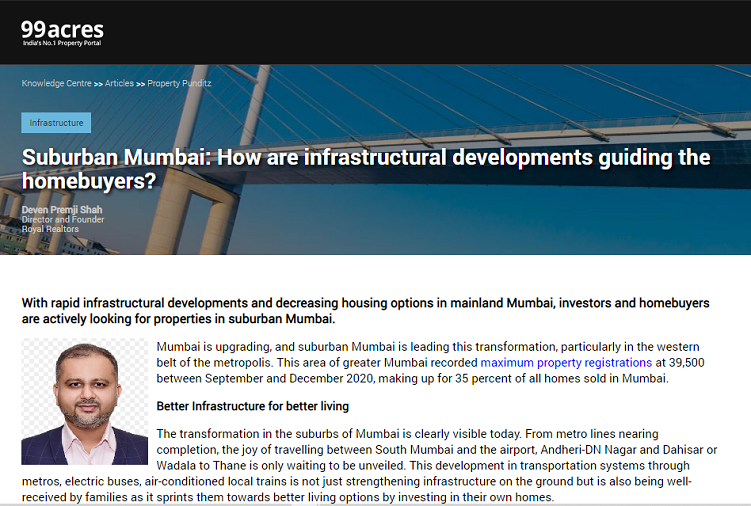
With rapid infrastructural developments and decreasing housing options in mainland Mumbai, investors and homebuyers are actively looking for properties in suburban Mumbai.
Mumbai is upgrading, and suburban Mumbai is leading this transformation, particularly in the western belt of the metropolis. This area of greater Mumbai recorded maximum property registrations at 39,500 between September and December 2020, making up for 35 percent of all homes sold in Mumbai.
Better Infrastructure for better living
The transformation in the suburbs of Mumbai is clearly visible today. From metro lines nearing completion, the joy of travelling between South Mumbai and the airport, Andheri-DN Nagar and Dahisar or Wadala to Thane is only waiting to be unveiled. This development in transportation systems through metros, electric buses, air-conditioned local trains is not just strengthening infrastructure on the ground but is also being well-received by families as it sprints them towards better living options by investing in their own homes.
Such is the availability of options in the residential space that Mumbaikars from the island city or South Mumbai are now moving to the suburbs. A better Floor Space Index (FSI) available in the suburbs is just one of the many reasons. Homebuyers are closely following the development of civic infrastructure across the city when it comes to making that precious home purchase decision.
The local trains, now complemented by the upcoming metro lines, the Eastern Freeway and the planned Coastal Road, will go a long way in freeing up our roads from congestion and offer multiple options to make commuting easy and safe.
While improving connectivity between the eastern and western suburbs significantly, the planned Goregaon-Mulund Link Road will considerably contribute to the growth of home buying as commuting will become far easier, and homes will fetch a higher value.
Recently, the Brihanmumbai Municipal Corporation, Asia’s richest civic body, tabled its Rs 39,038.83 crore annual budget for Mumbai. The civic body has earmarked around Rs 18,750.99 crore to be spent on capital expenditure.
This spends on capital expenditure is 28 percent more than the estimated amount of last year. This amount will be used for suburban Mumbai in the form of an important sewage treatment plant - STP project, coastal road, hydro-panels to generate solar power, desalination plants, rejuvenation of Mithi river, Dahisar, Poisar rivers, construction of bridges and up-gradation of hospitals, which the COVID-19 pandemic has made all the more necessary.
Social infrastructure
Another important point that also gets ticked off is the development of a strong social infrastructure. Be it healthcare facilities, educational institutions, retail or options in sports and entertainment, Suburban Mumbai has a better offering.
The working class will not have to spend a large amount of their time travelling to Nariman Point anymore. Hubs like Goregaon, Malad and Andheri with SEEPZ, Powai, Kanjurmarg and BKC have now emerged, taking advantage of the on-ground infrastructure and underdevelopment projects.
While developing civic infrastructure like roads, flyovers, bridges, metro lines etc., is an ongoing process, it is actually the development of housing that dictates how this is developed.
In a post-pandemic world, families are looking at bigger homes, properties that are premium and offer amenities that match world-class standards. Residential projects are guided by the needs of the buyer, who picks a suburb based on the overall infrastructure that it has to offer and the availability of units, beginning with one BHK and more.
Sustainable development
As the city gets its infrastructure makeover, it is important that urban planners keep a tab on the pace of development. Keeping a check on this will ensure sustainable development and growth of the real estate sector. Only development of sustainable infrastructure will ensure planned growth of the city through actions like the State government’s concerted efforts towards creating the new airport, better connectivity to greater Mumbai etc. These activities must be complemented by the development of the real estate.
As the suburbs get redeveloped with much-needed civic infrastructure, travelling across Mumbai within minutes will soon become a reality. As the saying goes, for the real estate industry to flourish, infrastructure development is imperative. If created well and in-time, the real estate sector will be able to serve the homebuyers better.